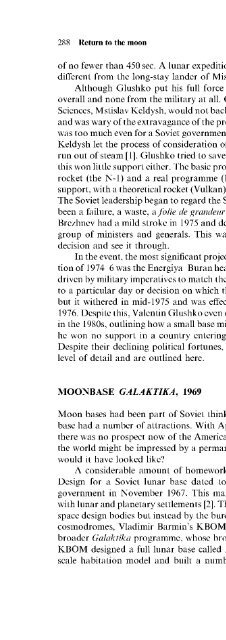Soviet and Russian Lunar Exploration
Soviet and Russian Lunar Exploration
Soviet and Russian Lunar Exploration
You also want an ePaper? Increase the reach of your titles
YUMPU automatically turns print PDFs into web optimized ePapers that Google loves.
of no fewer than 450 sec. A lunar expeditionary craft or LEK was designed, not that<br />
different from the long-stay l<strong>and</strong>er of Mishin's N1-L3M plan.<br />
Although Glushko put his full force behind Zvezda, it attracted little support<br />
overall <strong>and</strong> none from the military at all. Crucially, the president of the Academy of<br />
Sciences, Mstislav Keldysh, would not back it. He was never a close friend of Glushko<br />
<strong>and</strong> was wary of the extravagance of the project. The cost, estimated at 100bn roubles,<br />
was too much even for a <strong>Soviet</strong> government not normally shy of extravagant projects.<br />
Keldysh let the process of consideration of the project exhaust itself so that it would<br />
run out of steam [1]. Glushko tried to save some face with a scaled-down project, but<br />
this won little support either. The basic problem was that Glushko had replaced a real<br />
rocket (the N-1) <strong>and</strong> a real programme (N1-L3M), both with diminishing political<br />
support, with a theoretical rocket (Vulkan) <strong>and</strong> a programme (Zvezda) that had none.<br />
The <strong>Soviet</strong> leadership began to regard the <strong>Soviet</strong> manned moon programme as having<br />
been a failure, a waste, a folie de gr<strong>and</strong>eur that the country could not afford. Leonid<br />
Brezhnev had a mild stroke in 1975 <strong>and</strong> decisions were taken ever more by a shifting<br />
group of ministers <strong>and</strong> generals. This was not a leadership that would take a big<br />
decision <strong>and</strong> see it through.<br />
In the event, the most significant project to emerge from the strategic reconsideration<br />
of 1974-6 was the Energiya-Buran heavy launcher <strong>and</strong> shuttle system, which was<br />
driven by military imperatives to match the American space shuttle. No one can point<br />
to a particular day or decision on which the <strong>Soviet</strong> manned moon programme died,<br />
but it withered in mid-1975 <strong>and</strong> was effectively gone by March the following year,<br />
1976. Despite this, Valentin Glushko even once briefly returned to the moon base idea<br />
in the 1980s, outlining how a small base might be built using the Energiya rocket, but<br />
he won no support in a country entering ever more difficult economic conditions.<br />
Despite their declining political fortunes, the moon base projects reached a certain<br />
level of detail <strong>and</strong> are outlined here.<br />
MOONBASE GALAKTIKA, 1969<br />
Moon bases had been part of <strong>Soviet</strong> thinking for some time. For Glushko, a moon<br />
base had a number of attractions. With Apollo over <strong>and</strong> the shuttle in development,<br />
there was no prospect now of the Americans establishing a moon base. By contrast,<br />
the world might be impressed by a permanent <strong>Soviet</strong> settlement on the moon. What<br />
would it have looked like?<br />
A considerable amount of homework had already been done on moon bases.<br />
Design for a <strong>Soviet</strong> lunar base dated to the Galaktika project, approved by the<br />
government in November 1967. This m<strong>and</strong>ated the study of the issues associated<br />
with lunar <strong>and</strong> planetary settlements [2]. The work was done not by one of the normal<br />
space design bodies but instead by the bureau associated with the construction of the<br />
cosmodromes, Vladimir Barmin's KBOM. Work began in March 1968. Within the<br />
broader Galaktika programme, whose broad remit was the solar system as a whole,<br />
KBOM designed a full lunar base called Kolumb, or Columbus, constructed a fullscale<br />
habitation model <strong>and</strong> built a number of scale models, making its report as







